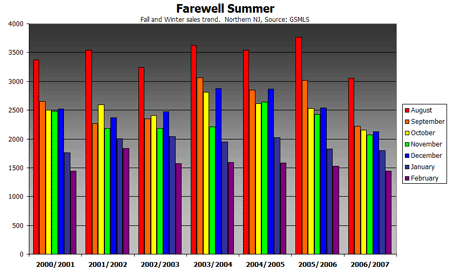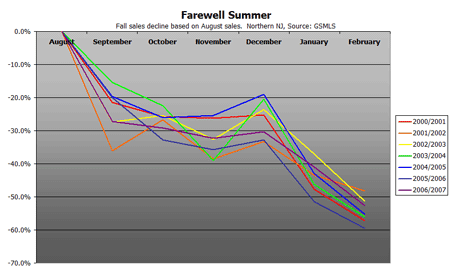Welcome to another edition of Lowball!
Lowball! takes a look at home sales from a different perspective. For those new to Lowball!, a lowball offer is when a buyer offers a significantly lower bid than asking in hopes that the seller accepts the offer. We take a list of home sales from the past month and pick out the sales that have the highest percentage difference between original list price and selling price.
Since I haven’t done a Lowball! in a few months, there is quite a bit of data to be displayed. To make it easier to post, as well as easier on me, I’m going to post these up on a county-by-county basis over the next few days. We’re going to start with Bergen, and move through the counties alphabetically. Keep in mind the Bergen Lowball! sales are sourced from GSMLS, not NJMLS, so a significant number of sales are missing from the data.
On to the list!
| MLS | Town | OLP | LP | SP | % off OLP | $ off OLP |
| 2337734 | Hackensack City | $1,175,000 | $925,000 | $850,000 | 27.7% | $325,000 |
| 2389558 | Ramsey Boro | $1,250,000 | $999,938 | $950,000 | 24.0% | $300,000 |
| 2345985 | Garfield City | $319,900 | $265,000 | $245,000 | 23.4% | $74,900 |
| 2383480 | Ridgewood Village | $729,900 | $565,000 | $560,000 | 23.3% | $169,900 |
| 2392716 | Oakland Boro | $444,500 | $359,900 | $350,000 | 21.3% | $94,500 |
| 2352992 | Fair Lawn Boro | $400,000 | $300,000 | $318,000 | 20.5% | $82,000 |
| 2359059 | Oakland Boro | $419,000 | $375,000 | $335,000 | 20.0% | $84,000 |
| 2370524 | Glen Rock Boro | $1,245,000 | $1,073,000 | $998,000 | 19.8% | $247,000 |
| 2363313 | Glen Rock Boro | $1,150,000 | $1,050,000 | $930,000 | 19.1% | $220,000 |
| 2351448 | Wyckoff Twp. | $799,900 | $699,000 | $650,000 | 18.7% | $149,900 |
| 2288917 | Franklin Lakes | $719,900 | $639,000 | $585,000 | 18.7% | $134,900 |
| 2239795 | Fair Lawn Boro | $369,000 | $337,900 | $300,000 | 18.7% | $69,000 |
| 2304593 | Rutherford Boro | $599,000 | $525,000 | $490,000 | 18.2% | $109,000 |
| 2343246 | Ridgewood Village | $689,000 | $599,900 | $565,000 | 18.0% | $124,000 |
| 2379258 | Harrington Park | $634,900 | $536,000 | $521,000 | 17.9% | $113,900 |
| 2366677 | Hillsdale Boro | $999,000 | $849,900 | $825,000 | 17.4% | $174,000 |
| 2381954 | Ridgewood Village | $575,000 | $500,000 | $475,000 | 17.4% | $100,000 |
| 2373561 | Garfield City | $399,000 | $379,900 | $330,000 | 17.3% | $69,000 |
| 2385159 | Fair Lawn Boro | $409,900 | $369,900 | $340,000 | 17.1% | $69,900 |
| 2387977 | Fair Lawn Boro | $239,000 | $219,000 | $200,000 | 16.3% | $39,000 |
| 2326403 | Waldwick Boro | $639,000 | $599,000 | $535,000 | 16.3% | $104,000 |
| 2359581 | Fair Lawn Boro | $739,000 | $649,000 | $620,000 | 16.1% | $119,000 |
| 2344733 | Saddle River Boro | $2,499,000 | $2,299,000 | $2,100,000 | 16.0% | $399,000 |
| 2396552 | Ridgewood Village | $1,495,000 | $1,385,000 | $1,260,000 | 15.7% | $235,000 |
| 2388007 | Fair Lawn Boro | $239,000 | $219,000 | $201,500 | 15.7% | $37,500 |
| 2370727 | Rutherford Boro | $258,900 | $238,000 | $219,000 | 15.4% | $39,900 |
| 2409191 | Franklin Lakes | $1,999,900 | $1,999,900 | $1,700,000 | 15.0% | $299,900 |
| 2327838 | Waldwick Boro | $599,000 | $529,900 | $510,000 | 14.9% | $89,000 |
| 2328085 | Tenafly Boro | $1,387,000 | $1,255,000 | $1,190,000 | 14.2% | $197,000 |
| 2384248 | Oakland Boro | $739,900 | $739,900 | $635,000 | 14.2% | $104,900 |
| 2304254 | Oakland Boro | $529,900 | $469,900 | $455,000 | 14.1% | $74,900 |
| 2320344 | Mahwah Twp. | $559,000 | $524,000 | $480,000 | 14.1% | $79,000 |
| 2409177 | Emerson Boro | $899,900 | $849,900 | $775,000 | 13.9% | $124,900 |
| 2412730 | Franklin Lakes | $8,445,000 | $8,445,000 | $7,300,000 | 13.6% | $1.145m |
| 2370198 | Ridgewood Village | $925,000 | $795,000 | $800,000 | 13.5% | $125,000 |
| 2318280 | Paramus Boro | $379,000 | $349,900 | $330,000 | 12.9% | $49,000 |
| 2398117 | Lodi Boro | $327,000 | $319,000 | $285,000 | 12.8% | $42,000 |
| 2387315 | Garfield City | $389,900 | $369,900 | $340,000 | 12.8% | $49,900 |
| 2395588 | Ridgewood Village | $749,000 | $699,000 | $655,000 | 12.6% | $94,000 |
| 2300974 | Mahwah Twp. | $849,000 | $774,900 | $742,500 | 12.5% | $106,500 |
| 2372219 | Rochelle Park Twp. | $479,900 | $439,900 | $420,000 | 12.5% | $59,900 |
| 2402380 | Glen Rock Boro | $439,900 | $424,900 | $385,000 | 12.5% | $54,900 |
| 2378161 | Wyckoff Twp. | $899,900 | $825,000 | $789,000 | 12.3% | $110,900 |
| 2390180 | Wyckoff Twp. | $815,000 | $749,900 | $714,800 | 12.3% | $100,200 |
| 2304941 | Saddle Brook Twp. | $469,900 | $445,000 | $412,500 | 12.2% | $57,400 |
| 2384515 | Wyckoff Twp. | $1,195,000 | $1,135,000 | $1,050,000 | 12.1% | $145,000 |
| 2399768 | Midland Park Boro | $995,000 | $919,000 | $875,000 | 12.1% | $120,000 |
| 2392235 | Oakland Boro | $699,000 | $629,000 | $615,000 | 12.0% | $84,000 |
| 2390143 | Allendale Boro | $1,079,000 | $989,000 | $950,000 | 12.0% | $129,000 |
| 2366817 | Waldwick Boro | $464,900 | $435,000 | $410,000 | 11.8% | $54,900 |
| 2363581 | Ridgewood Village | $1,700,000 | $1,700,000 | $1,500,000 | 11.8% | $200,000 |
| 2325320 | Allendale Boro | $699,000 | $619,000 | $620,000 | 11.3% | $79,000 |
| 2378810 | Wyckoff Twp. | $689,000 | $649,000 | $612,000 | 11.2% | $77,000 |
| 2320022 | Upper Saddle River | $1,095,000 | $999,900 | $975,000 | 11.0% | $120,000 |
| 2316931 | Rutherford Boro | $480,000 | $460,000 | $427,500 | 10.9% | $52,500 |
| 2381664 | Ridgewood Village | $595,000 | $565,000 | $530,000 | 10.9% | $65,000 |
| 2335667 | Waldwick Boro | $425,000 | $385,000 | $379,812 | 10.6% | $45,188 |
| 2383061 | Oakland Boro | $575,000 | $525,000 | $514,000 | 10.6% | $61,000 |
| 2359654 | River Edge Boro | $559,000 | $537,000 | $500,000 | 10.6% | $59,000 |
| 2382077 | Ridgewood Village | $689,999 | $639,000 | $617,500 | 10.5% | $72,499 |
| 2366742 | Ramsey Boro | $550,000 | $518,000 | $493,000 | 10.4% | $57,000 |
| 2417655 | Elmwood Park | $484,900 | $465,000 | $435,000 | 10.3% | $49,900 |
| 2319779 | Upper Saddle River | $924,900 | $849,900 | $830,000 | 10.3% | $94,900 |
| 2379186 | Mahwah Twp.* | $919,000 | $850,000 | $825,000 | 10.2% | $94,000 |
| 2415583 | Fair Lawn Boro | $529,000 | $499,000 | $475,000 | 10.2% | $54,000 |
| 2379809 | Tenafly Boro | $739,000 | $669,000 | $664,000 | 10.1% | $75,000 |
| 2362254 | North Arlington Boro | $345,000 | $310,000 | $310,000 | 10.1% | $35,000 |
| 2294893 | Wyckoff Twp. | $739,900 | $739,900 | $665,000 | 10.1% | $74,900 |
| 2385816 | Wyckoff Twp. | $839,900 | $839,900 | $755,000 | 10.1% | $84,900 |
| 2380369 | Upper Saddle River | $1,099,000 | $1,099,000 | $989,000 | 10.0% | $110,000 |
| 2413091 | Ridgewood Village | $524,900 | $499,000 | $472,500 | 10.0% | $52,400 |
| 2391823 | Garfield City | $399,900 | $389,000 | $360,000 | 10.0% | $39,900 |


